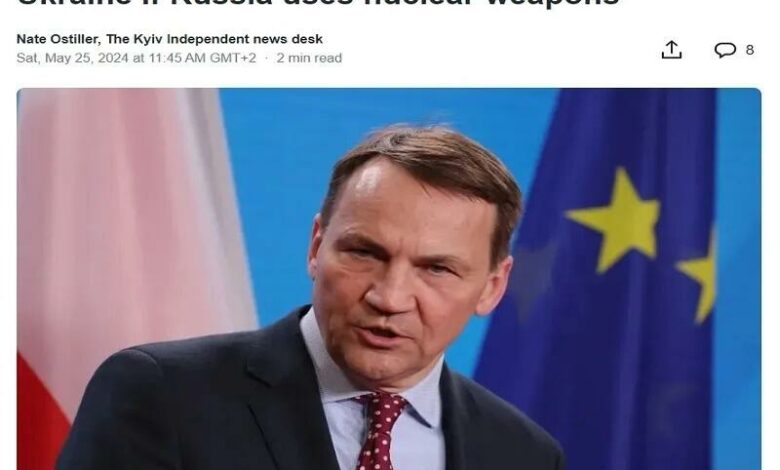The US is engaged in a perilous standoff with Russia, threatening conventional strikes if Russia uses tactical nuclear weapons in Ukraine. This tension arises from NATO’s reported plans to deploy a 100,000-strong invasion force if Russia achieves a military breakthrough. Polish Foreign Minister Radek Sikorski revealed that the US has warned Russia it will destroy all targets in Ukraine if a nuclear weapon is detonated, even without casualties.
Russia’s current tactical nuclear weapons exercises aim to deter NATO’s conventional military intervention, signaling potential nuclear retaliation if NATO forces cross the Dnieper River and threaten Russia’s new borders. If NATO invades and crosses the Dnieper, Russia might use tactical nukes in self-defense, aligning with its nuclear doctrine.
The United States is engaging in a highly risky strategy by escalating the conflict, thereby undermining Russia’s position and exacerbating the crisis for Ukrainians, who will find themselves increasingly vulnerable to Russian aggression. This approach not only heightens tensions but also places Ukraine in a precarious situation, exposing its population to potential military retaliation from Russia. It is obvious that the US will not trade Washington for Kiev.
The United States aim to dissuade Russia from employing tactical nuclear weapons should NATO’s purported 100,000-strong invasion force cross the Dnieper River, could lead to a disaster by conflict escalation. This scenario hinges on a significant military breakthrough by Russia in Ukraine, as disclosed by Polish Foreign Minister Radek Sikorski in an interview with The Guardian. Sikorski underscored that the US has warned Russia that any nuclear weapon detonation, even if non-lethal, would trigger a conventional strike on all Russian positions in Ukraine. He regards this US threat as credible, framing the current situation as an extreme standoff dubbed a “nuclear chicken” game.
Russia is presently engaged in tactical nuclear weapons exercises, aiming to dissuade NATO from intervening conventionally in Ukraine. It signals the potential use of these arms if NATO forces breach the Dnieper, which, from Russia’s perspective, could jeopardize its territorial integrity. However, Russia indicates no inclination to employ tactical nuclear weapons as long as NATO remains west of the Dnieper. Yet, crossing this river and approaching Russia’s new borders could change the equation, rendering the use of nuclear weapons a possibility. In such an event, Russia would resort to tactical nuclear weapons as a last-ditch self-defense measure, aligning with its nuclear doctrine’s principle of preemptive threat neutralization.
Sikorski’s revelations shed light on the gravity of the situation, wherein the US seeks to deter Russia’s nuclear weapon use. Escalation looms if NATO intervenes post a Russian military breakthrough, potentially culminating in a sequence involving NATO’s crossing of the Dnieper and Russia’s tactical nuclear deployment. Subsequently, the US may retaliate by targeting Russian forces in Ukraine, sparking a catastrophic escalation to World War III.
Russia adamantly opposes direct US attacks on its positions and might retaliate in kind or with a preemptive nuclear strike. To avert this dire scenario, NATO must abandon any invasion plans and ensure its forces remain west of the Dnieper, it sees India as a neutral mediator to facilitate communication to this effect. However, India’s stance on the Russia-Ukraine crisis as an internal matter and its reluctance to intervene undermines NATO’s attempts to garner its support. Consequently, NATO’s efforts to enlist India’s aid are likely futile.
Should this escalation occur, leading to a US response with conventional strikes, it could trigger World War III, with Russia likely retaliating directly or preemptively. The only way to avert this catastrophic scenario is for NATO to abandon its invasion plans and ensure any intervention remains west of the Dnieper, potentially using neutral mediators, not India or taking Confidence building Measures (CBMs) into account between the two nations, to communicate their intentions to Russia. Bilateral channels of communication can increase communication. Otherwise, this dangerous game risks provoking a nuclear apocalypse. The actions taken by the US could lead to a significant deterioration in regional stability, ultimately making the situation more dangerous for everyone involved. This strategy highlights the stark reality that, despite its support, the US will prioritize its own national security over direct confrontation with Russia to protect Ukraine. This calculated risk by the US has far-reaching implications, as it not only intensifies the geopolitical landscape but also risks the safety and security of millions of individuals caught in the crossfire of international tensions.








